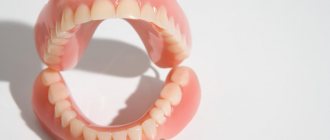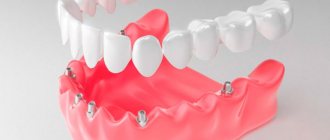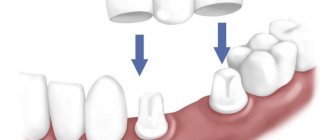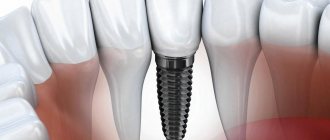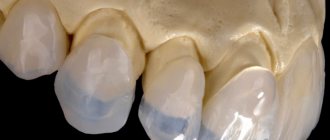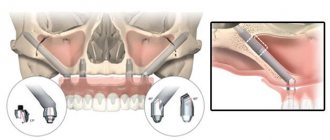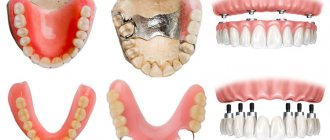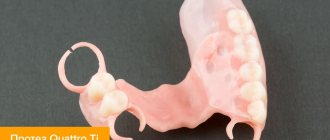Preparation for prosthetics is a set of important measures necessary for subsequent health and restoration of dental functionality. The preparatory period before dental prosthetics includes a complete examination and sanitation of the patient’s oral cavity to prevent possible complications and obtain ideal results.
Preparation for dental prosthetics begins with a dental consultation and examination of the patient to determine the approximate scope of preparatory actions.
Experts conditionally divide the period of preparation for prosthetics into the following stages:
- Therapeutic stage;
- Surgical stage;
- Orthodontic stage.
Survey
Diagnostics helps to accurately assess the condition of teeth, gums, and facial bones and determine the optimal method of treating edentulism. To do this, the dentist:
- Interviews the patient and listens to complaints.
- Examines all organs of the oral cavity - teeth, gums, tongue.
- Prescribes radiography or CT (computed tomography).
The images help determine whether the teeth adjacent to the defect are suitable for use as supports. Sometimes, after radiography, it also turns out that adjacent units are not suitable for adjacent implants or bridges.
Assessment and modification of occlusion at the orthodontic stage
This can be the longest part of the treatment, since correcting the bite, changing the position and creating favorable conditions for prosthetics due to this is a long process. It can take from several months to 3 years, but it is necessary for the reason that the shape, type, size of the finished structure (fixed prosthesis or crown) are selected and built into a ready-made series. For example, a tooth has been missing for a long time; over the years, neighboring units have shifted towards the void and distorted the row. Before restoring such an element, you will need to make room for it and equalize the deformation. And this is not the most difficult situation.
What procedures are possible:
- It happens that it is necessary to pull out a retained element (that has not appeared on the surface). Upon completion of the procedure, it will become a support for the prosthesis,
- change the inclination and curvature of teeth,
- correct the fan-shaped position,
- change the shape of the row,
- straighten the position of the supports,
- create an additional place.
All this is done with the help of orthodontic devices: braces, mouth guards, bite plates. In addition to their main functions, these devices help correct defects in the dental system and help correct pathologies of the temporomandibular joint.
Strengthening teeth that are loose in the first degree is also carried out with the help of orthodontic elements - splints. They allow you to strengthen the row: moving elements are taken into the system with healthy ones thanks to fiberglass threads or metal wire. Some types of prostheses - clasp and cable-stayed - can also act as splinting.
Don't know what type of prosthetics to choose?
We will help in the selection, advise where to read more information and compare types of prosthetics.
Consultation with an orthopedic doctor in Moscow clinics is free! Call now or request a call
Working hours: from 9:00 to 21:00 - seven days a week
Preparation for installation of prostheses
After diagnosis, the doctor explains the clinical situation to the patient and proposes a plan for further action. In particular, he tells where to start with dental prosthetics, recommends and agrees on the method, and suggests types of structures. After this, the preparation of the oral cavity for their installation begins:
- Treatment of caries and pulpitis is carried out if these diseases are detected during the diagnostic process.
- Pathological changes in soft tissues that may become an obstacle to prosthetics are identified and eliminated.
- Depulpation (removal of the dental nerve) is performed if there are indications for it. For example, such manipulation may be necessary to prepare teeth for the installation of single crowns or bridge structures.
- The hard tissues of the supporting teeth are prepared. The dentist removes a layer of enamel and dentin in order to form a tooth stump for the crown.
- The remaining part of the tooth is strengthened. For this purpose, stump inlays or pins can be installed.
One of the stages of preparation for prosthetics may also be the installation of dental implants, which will become supports for crown-like or bridge structures.
Why take tests before dental implantation?
Our patients undergo blood and, in some cases, urine tests MANDATORY and FREE of charge before dental implantation - their cost is included in the price of dental implantation, especially when a comprehensive restoration is planned according to one of the “teeth in 1 day” protocols. Tests make it possible to assess the patient’s current health status, clarify blood clotting readings, and the presence or absence of viral or bacterial infections in the acute period.
After the tests, we are unlikely to refuse you dental implantation - when planning treatment, you already fill out a questionnaire that allows us to draw conclusions about the state of your health. But the tests will allow us to understand whether implantation can be carried out right now or whether it makes sense to postpone it for a while and put chronic diseases into remission.
We especially insist on testing for women over 50 years of age: an expanded complex is provided for them, since during this period it is necessary to take into account that some body functions work slightly differently. You can read more about the specifics of implantation in women in our special article.
An expanded list of tests is also provided if the patient plans to undergo implantation under general anesthesia or sedation.
Manufacturing of prostheses
After sanitizing the oral cavity and preparing the teeth for the installation of prosthetic structures, the orthopedic dentist begins his work. First of all, he takes impressions from the patient’s jaws, on the basis of which the dental technician will work. For this procedure, special impression materials are used.
All manipulations performed are completely painless and do not cause any particular discomfort to the patient. Taking impressions generally takes no more than 20–30 minutes. The resulting impressions are sent to a dental laboratory, where prosthetic structures will be made from them.
Should I see a therapist or other doctor?
We strongly ask our patients to approach filling out the health questionnaire responsibly - it is important for us to know how your body may behave during the operation to install implants and to provide for all the nuances. Therefore, you must tell your doctor in advance that you are registered with a specialized specialist, especially if you have diabetes and pathologies of the cardiovascular system. In this case, we will need a doctor's opinion on what stage the disease is at. You may also have to do an ECG, ultrasound of the thyroid gland, take allergy tests - everything is individual.
We perform implantation in cases of diabetes mellitus and problems with blood pressure or the cardiovascular system in general. But it is important that the disease is in the stage of compensation and remission. In addition, you definitely need to be in touch with your endocrinologist or cardiologist and know what medications you need to take before and after surgery.”
Namdakov Nikolay Vladimirovich, maxillofacial surgeon, implantologist, orthopedist with more than 17 years of experience make an appointment
Installation of prostheses
When the crowns or dental bridges are ready, the final stage of prosthetics will begin. Installation of structures is carried out in accordance with the chosen method. If removable dentures are performed, the doctor shows the patient how to properly put on and remove the structure from the mouth. A specialist fixes permanent crowns and bridges in such a way that they are securely held on the supporting elements. There is no need to remove such dentures yourself; they remain in the oral cavity permanently.
Before installation, fittings are carried out to show whether adjustment (correction) of the structure is required. After the patient approves the prosthesis, the dentist performs its final fixation.
SURGICAL STAGE
- Removal of untreatable and dead teeth and roots;
- Removal of existing exostoses and osteophytes that interfere with the installation of the prosthesis;
- Removal of soft gum tissues subject to hypertrophy and other areas of the mucous membrane;
- Intervention to deepen the vestibule of the oral cavity, plastic surgery of the tongue, frenulum, upper or lower lip - if necessary;
- Installation of implants for fixed dental prosthetics and to create support for removable denture structures;
- Performing osteoplasty - building or removing bone tissue;
- Carrying out a sinus lift in the upper jaw to raise the bottom of its sinus. This is necessary to create space for a dental implant.
The surgical stage requires recovery of the body for about 2 months before prosthetics.
Dental prosthetics - types and prices
The cost of prosthetics depends on the type of technique, materials, complexity of the case, and can differ by orders of magnitude. As, for example, restoration of complete edentia, performed on an acrylic prosthesis using the All-on-4 protocol.
Crowns made from a dental base alloy or metal-plastic are inexpensive. Metal-ceramic ones are significantly more expensive. The most expensive ones are made of zirconium dioxide.
The same applies to prosthetics on implants. Constructions with a standard titanium abutment covered with a metal-ceramic crown will cost significantly less than with an individual zirconium abutment and zirconium crown. If before implantation it is necessary to perform a sinus lift (bone tissue augmentation), this will lead to an increase in the cost of the procedure.
Therefore, the doctor will be able to tell you the exact amount of prosthetics after the method and materials have been selected, and all the features of your case have been taken into account.
Removable prosthetics
A removable denture is a solid plate or prefabricated structure (clasp), with artificial teeth soldered onto it, which a person can put on and take off himself. Recommended for patients with partial and complete edentia (absence of teeth).
Removable dentures can be of two types:
- Partial. It is used for incomplete edentia, when it is not possible to install a bridge or implants. They are attached to the remaining natural teeth using clasps (hooks) or locks.
- Full. Installed in case of complete edentia on one or two jaws. Before the advent of dental implantation, this method of prosthetics was the only one for complete absence of teeth. Now new possibilities have emerged, including permanent prosthetics.
Fact! According to statistics, removable dentures are used 4 times more often than fixed dentures. This is because the loss of a large number of teeth is more common in older people, who often have limitations, both clinical and financial, for the installation of fixed structures.
Based on materials and manufacturing techniques, removable systems are divided into plate and clasp systems. The latter are used only for partial prosthetics.
Plate design
It is precisely these “pullers” that are associated with dentures in a glass, although modern materials have not needed such storage for a long time and can easily do without water.
The prosthesis is a solid plate, which consists of a base and teeth soldered onto it. The base is made to match the color of the gums, follows their outlines, and is in close contact with the palate, creating a so-called prosthetic bed that takes the chewing load.
Due to the blocking of the palatal part, patients experience impaired diction, taste perception, and sometimes even a gag reflex. Therefore, this design requires some getting used to.
Most often, the following types of plates are used:
- Acrylic. Inexpensive, easy to implement and repair, accessible to all segments of the population. Rigidity, relative heaviness, as well as a large amount of base make them more difficult to get used to. In this case, the chewing load is transmitted throughout the entire prosthetic bed, which allows chewing coarse-fiber foods and causes less degradation of the jaw bone.
- Nylon. Lighter and more comfortable due to the elastic base. Its boundaries are smaller, so it is easier to get used to the prosthesis. They cost more than acrylic ones. Due to flexibility, the load during chewing is distributed unevenly. Therefore, chewing hard food with such a plate is inconvenient, and long-term wearing of it causes greater atrophy of the jaw bone compared to its acrylic counterpart.
Partial plate structures are attached to the teeth using clasps.
Clasp prosthesis
This is a prefabricated system made on the basis of a metal arc onto which artificial teeth, a base, and also locking fasteners are soldered.
The clasp is used for partial dentures. It is attached to your own teeth using clasps, locks (attachments) or crowns. This system is lightweight, convenient, reliable and aesthetic - artificial crowns for it can be made of metal-ceramics or ceramics. The base applies only to the gums, without affecting the palate, and therefore does not cause problems with diction, taste sensations, and does not require long-term adaptation.
Clasp dentures cost significantly more than plate dentures. They have a sufficient number of medical restrictions.
Microprosthetics
Its goal is to correct aesthetic defects or restore dental tissue if it is severely damaged.
Veneers and Lumineers
Veneers are thin ceramic shells that are attached to the front teeth. They are used in aesthetic dentistry to correct imperfections in the smile area - dark enamel, irregular dentition.
To install veneers, it is necessary to cut down a small layer of enamel from the front surface of the teeth. After their removal, this layer has to be built up with filling material, which is one of the disadvantages of such microprostheses.
Lumineers are very thin veneers, so they do not require cutting of dental tissue and can be removed if necessary. But their small thickness makes the material highly transparent, so such plates cannot hide significant color defects in the enamel.
The cost of veneers, and especially lumineers, is quite high.
Tabs
The inlay resembles a filling, but is cast from hard materials (ceramics, precious alloys) in a technical laboratory based on a cast of the patient’s jaw. It is stronger than a composite filling and significantly extends the life of the tooth.
It is recommended to install it when the crown is significantly damaged (25–50%).
Adhesive bridge
If previous microprostheses are used for partial tooth destruction, an adhesive bridge replaces the completely lost unit (maximum two).
This is a gentle technique - the artificial tooth “sticks” to its neighbors using composite materials or fiberglass, which means there is no need to grind them down.
It is an inexpensive system that can be installed in one visit. Its disadvantage is its relative fragility and fragility, but if it breaks, it can be repaired directly in the patient’s oral cavity.
The planned service life of the adhesive bridge is about 5 years. It is better to install this design in the smile area, where the chewing load is low. An adhesive bridge is often used as a temporary measure while a permanent prosthesis is being made.
How to make an appointment?
You might be interested to know that 90% of an orthopedic dentist’s time is spent talking, examining, photographing, discussing, making all kinds of corrections, drawing up treatment plans, and only ten percent is spent directly on manipulations related to prosthetics.
Therefore, before your first meeting with an orthopedist, try to be as specific as possible about your wishes regarding future dental restoration. The better you imagine it, at least for yourself, the easier, faster and, most importantly, cheaper your treatment will be.
Also, don’t wait until your old dentures become unusable and fall off on their own. The appearance of mobility of crowns both on natural teeth and on implants is always a bad sign; this mobility will not go away on its own, and its increase can lead to subsequent loss of both teeth and implants.
Usually, at the first prosthetics meeting, only diagnostics are carried out - to a greater extent, this is a conversation and discussion. Also, during the consultation, pictures and photographs of the teeth are taken so that there is something to talk about in detail. And draw up a treatment plan, the so-called “road map”, which will include all the necessary procedures, from caries treatment to bite correction and implantation. And sometimes one meeting is not enough for this - so, before starting a large and complex work, one, two or three consultations are held, including consultations with other dental specialists.
All this time, the orthopedic doctor is trying to answer the question:
“How to fulfill all your wishes for the beauty and functionality of your teeth as rationally, reliably and durablely as possible?”
Indeed, it is very easy to make your teeth “simply beautiful” - remove everything, make two removable dentures - and you will have “beauty”! How to live further with this beauty, how to chew, smile, talk, kiss - another, more complex and delicate question. That is why high-quality and reliable dental prosthetics is somewhat more than “metal-ceramics for three thousand rubles,” and an orthopedic dentist is not just a “teeth sharpener” and an “impression machine.”
Be prepared for the fact that consultations on prosthetics are usually long. They take at least 45 minutes. As we wrote above, a consultation with the involvement of other specialists may be required, so have a reserve of time.
It is unlikely that at the first consultation the doctor will remove your old dentures (if they have not completely fallen apart) or grind your teeth. But, to fully assess the clinical situation, some examination may be required, namely:
- photographing and drawing up a photo map (at CLINIC IN – free of charge)
- taking impressions and making diagnostic models of the dentition (in CLINIC IN – from 3500 to 5000 rubles)
- X-ray examination - computed tomography (4,200-2,100 rubles), orthopantomography (2,200-1,100 rubles), targeted photographs of teeth (550-240 rubles)
The consultation itself in our clinic costs from 0 to 2,000 rubles. But for good people it is always free.
Recommendations for the patient: what to do before the operation to install implants
So, all the stages of preparation and planning have been completed, the date for installing the implants has been set, all that’s left to do is sleep, eat and get ready for the speedy completion of the treatment, after which you will find a beautiful smile and will finally be able to eat without pain. And those products that you really want, and not just can chew.
Please charge your phone fully so that after surgery you can contact your loved ones and stay in touch with your doctor. You can also leave your phone at the reception desk - after the operation it will be completely ready for communication.
It is advisable to arrive at the clinic 20-30 minutes before the start of the operation. Please do not be late, especially if general anesthesia or sedation is planned. We may have several operations on one day, and between them we need to have time to prepare the operating rooms.
What can you eat
- 2-3 days before surgery, it is advisable to follow a “light” diet - remove fatty, salty, fried, and rich foods from the diet. It is better to give preference to chicken, vegetables and fruits (apples, pears), fish, dairy products,
- do not drink coffee, tea, or alcohol for 2-3 days, as they provoke sudden changes in blood pressure - this can lead to bleeding after surgery,
- eat 2 hours before surgery. DO NOT overeat! Light but filling lunch/breakfast. This could be eggs, a small piece of meat and steamed vegetables, various cereals. Eat complex carbohydrates as they keep you full for a long period of time. If general anesthesia is planned, you should not eat 4 hours before
- You can only drink water before surgery. But if general anesthesia is planned, then stop taking any liquids 4 hours before surgery.
How to dress
- Wear light clothing that does not restrict movement. You can take with you a warm jacket with a zipper or buttons in the front so that you can simply take it off (not over your head) or throw it on if it gets cold,
- It is advisable that clothing be sleeveless, since installing implants is a surgical operation and although protective aprons are used, clothing can become dirty,
- It is advisable for women not to wear makeup or to wash it off at the clinic. You especially need to give up lipstick. During installation of the implants, a protective balm will be used to prevent dry lips,
- You should not paint or extend your nails, since special infrared sensors placed on the fingers are used to monitor the respiratory function and the patient’s condition during implantation. Varnish, acrylic and gel coatings can impede data transfer. Moreover, anesthesiologists monitor the effect of anesthesia and the patient's condition by observing the nail plates.
How to perform hygiene
- immediately before the operation, brush your teeth well with a brush and toothpaste, use an irrigator,
- immediately before leaving the house, that is, after eating, rinse your mouth with a solution of Chlorhexidine, Miramistin or any other antiseptic.
Do I need to take medications?
- necessary if they were prescribed to you by your attending physician,
- It is important that blood pressure readings are within normal limits. If you know that your blood pressure will rise as soon as you cross the threshold of a clinic or implantologist’s office, discuss this with your doctor in advance: together you will choose the optimal dose of the drug and determine how long before surgery it is best to take it,
- We also recommend that patients with panic fear breathe xenon before surgery - this is a useful medical gas that will relax, lift your spirits, and improve the general condition of the body. Read more about xenon therapy here.
- it is also necessary to maintain normal blood sugar levels - take all prescribed medications as prescribed by the endocrinologist,
- prohibited: anticoagulants, aspirin and drugs based on it, non-steroidal anti-inflammatory drugs and blood thinners. All of them increase the risk of postoperative bleeding,
- During preparation for implantation, you cannot undergo intensive therapy for the treatment of other diseases (hepatitis, cancer, tumors) associated with taking a large number of medications or radiation.
WHAT SHOULD BE IN YOUR HOME from medicines
When you return home, you will feel weak and have difficulty concentrating. Therefore, we strongly recommend that you prepare in advance - check out our useful reminder so you don’t forget to buy anything in advance.
- at the pharmacy: buy all the tablets and solutions for oral baths in advance - especially for painkillers. All recommendations will be given to you by the attending physician even before the operation. Also in your first aid kit you should have a thermometer to measure and control body temperature, a sterile bandage or napkin to apply to the wound area and stop bleeding,
- There should be a supply of ice in the freezer to reduce the risk of swelling. If swelling occurs, ice will help reduce its spread.
WHAT SHOULD BE FOOD AT HOME
- what to buy in the store: soft cottage cheese, various yoghurts, you can buy baby food in jars - give preference to meat products and vegetables. In the first 2 days, if you do not receive dentures immediately, your diet will consist exclusively of liquid and puree foods,
- What to cook at home: make your own broth. This can also be a regular soup, but it is better to use a blender before using it. On the first day, you can also afford mashed boiled vegetables and soft baby food. IMPORTANT! All food should be warm - neither hot nor cold,
- what you can drink: water is a priority, but you can indulge in warm herbal tea, especially one that has a sedative effect on the nervous system. Be sure to buy a straw - if you need stitches, you're better off eating this way.
Prepare a sleeping place in advance, stock up on interesting films or favorite music - they will help distract you on the first day after surgery and not focus on every sensation. The body has suffered stress and the tissues begin to rehabilitate – discomfort is normal. You will find a more detailed list of how to care for your oral cavity, how to eat, which symptoms are normal, and which should see a doctor in our post-implantation leaflet.
Checklist: check yourself!
| What to buy at the pharmacy | What to buy in the supermarket | What to cook at home |
|
|
|
We have quite a lot of recommendations on how to prepare for dental implantation. But we tried to take into account as much as possible so that you don’t forget anything. You can download our checklist and check yourself so that when you return after surgery, you have everything you need not only in stock, but also at hand. And remember, dental implantation is an operation that is sometimes even easier than complex tooth extraction. The main thing is a positive attitude and compliance with the instructions!
Is it possible to restore teeth on only one jaw?
It is possible, but the doctors at the Smile-at-Once clinic do not practice this. Yes, we can restore only one jaw, but the teeth will not have antagonists, that is, support. And it's not just that you won't be able to chew. The problem is much more serious - we will not have the conditions to create a fully functioning and properly functioning jaw system.
Firstly, if a tooth is missing on the opposite jaw, the living teeth can literally shift and even fall out of the socket. Indeed, over time, due to the lack of chewing pressure on them, blood circulation deteriorates, and the bone tissue, along with the periodontal ligaments, weakens. It’s the same with implants - they have no support, the crowns of the prosthesis have nothing to come into contact with unless the antagonists are restored. Nutrition of bone cells, which is so important for implant healing, is difficult due to impaired blood circulation.
Secondly, if you left some of your teeth, then with a 99% probability they have changed their original position - due to periodontitis, due to malocclusion, due to loss of bone tissue. That is, they moved sideways and definitely became shorter/longer (this is individual). In such a situation, we again cannot always restore the correct position of the two jaws relative to each other.
We need an integrated approach! If you are currently only ready to undergo implantation on one jaw, do not ignore the second. For a while, we can install a removable or conditionally removable denture - this will allow us to straighten the bite, ensure normal functioning of the jaw joint - you will be able to chew and enjoy your new teeth. Otherwise, you will understand that after implantation almost nothing has changed - only the smile has become beautiful, but the problems continue.
What determines the quality of prosthetics?
Advertisements that litter the Internet tend to focus on materials. For example:
- “Metal ceramics for 3,900 rubles!”
- “Zirconium crowns for 5,000 rubles, subsequent tooth extraction is free!”
- “Removable denture for 10 thousand”,
and so on.
Meanwhile, the role of materials in the quality of manufactured prostheses is greatly exaggerated. Ordinary metal-ceramic crowns can be made more aesthetically pleasing than ceramic ones, and they will be very different from each other, because it depends on who made them and how.
Let's show a simple example:
Therefore, we would highlight the “quality triad” - three components that determine how functional, aesthetic and durable your new teeth will be:
Total, by points:
- original components are necessary primarily for implant prosthetics. Now, for almost every implantation system, Chinese counterfeits are produced, and with the increase in the accuracy of digital milling machines, doctors and laboratories have the opportunity to produce the same abutments almost on the knee.
However, no one is yet able to replicate the original dimensions and alloys (the latter is important to avoid galvanism and corrosion). Therefore, all manufacturers of implantation systems will void the warranty if, during the examination of the doctor’s joint, any left-handed screw or abutment is found. Our dental center CLINIC IN works directly with the world's largest manufacturer of implantation systems, Dentsply Sirona Implants, we do not need to use counterfeit products to save money. Therefore, all our work, all original components we use, are covered by the manufacturer’s warranty. You can read more about this here>>. - highly qualified dental technician and well-equipped dental laboratory. Indeed, it is unlikely that we can offer you digital technologies if our laboratory does not have special equipment and trained personnel.
In addition, each dental crown, each prosthesis is, in fact, a piece of art - and the extent to which the dental technician masters this art will depend on the aesthetics of the final product. Making highly aesthetic dentures is a unique fusion of art, good taste and engineering. And, unfortunately, few dental technicians can offer a job worthy of you. And those who are, as a rule, are in great demand, so they ask for a lot of money for their services. Through a lengthy search and a very strict selection, our orthopedic doctors, David, Kirill and Ivan, selected four dental laboratories from thirty candidates, the quality of which would suit us and our patients. Yes, such work is not cheap, but you will never guess the artificial teeth in the smiles of our friends. We will definitely tell you about our partner laboratories in one of the future articles, since the manufacture of dentures is a very interesting and extensive topic. - a medical specialist is, in a way, the chief architect of any dental rehabilitation. His task includes not only preparing teeth and implants for fixing restorations and prostheses, but also managing the entire process of patient treatment - it is the orthopedic dentist who determines the placement scheme of implants, together with the dentist-therapist makes a decision on the preservation/removal of teeth, and gives recommendations on the form and the color of future crowns, and in some cases models them independently. Their service life largely depends on the orthopedic dentist’s understanding of the rules of prosthetics on implants, so when planning implantation, he is always somewhere nearby.
Our dental center employs highly qualified dental specialists who have undergone rigorous selection and testing with fire, water and copper pipes.
They can handle prosthetics of any complexity and any option, no matter what you choose. But, most importantly, they understand and accept your wishes, take into account your characteristics and needs, they restore YOUR teeth, not their own, so all their experience, all their competence and all their arsenal of means are aimed at achieving only one goal - you must like the result, first everything, to you. Chief's comment: The ability to hear and understand your patient is perhaps the main quality for a dentist involved in the aesthetic and functional rehabilitation of a smile. In the end, if function can be calculated and adjusted, then aesthetics is a subjective and individual concept for each of us. Just as there are no specific standards of beauty, there is no one generally accepted idea about the aesthetics of a smile. It’s the task of our doctors to figure this out and take into account what you need. It is their direct responsibility to realize what you want without loss of functionality, durability, reliability and comfort. That is why such doctors work for us.
